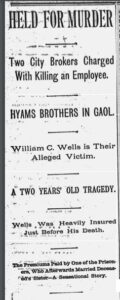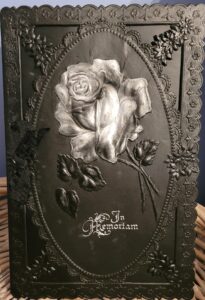I am available to speak to your community or professional groups, conference or special event. My presentations are based around local history, gravestones, cemeteries and genealogy and are accompanied by Power Point slides. Presentations can be conducted in person or on Zoom. Some of my most popular presentations are outlined below.
My Dearest Mina: A Tale of Love and Death in Victorian Toronto

The circumstances surrounding the death of William Wells in 1893 have all the earmarks of a fascinating Victorian thriller; love, death, betrayal and more than enough mystery. And the best part of the story is it’s true! William’s untimely death in Toronto was the subject of a sensational murder trial in Toronto. Was William’s death a case of pre-meditated murder or merely a tragic accident? Well, that all depends on who you ask.
Harry Hyams and Martha Wells met in 1889 at a summer resort in Northern Ontario and eventually married in 1893. By 1895, the marriage was over and Harry and twin brother Dallas were both on trial for the murder of Martha’s brother William in an alleged insurance scam. The trial captivated Victorian Toronto and made newspaper headlines in Canada and around the world. The twins were referred to in the media as “moral and physical degenerates,” and the case so popular with the people of Toronto that the courtroom was overflowing daily with spectators.
There were allegations of jury tampering, suspicions of judicial influence and bribery and the spectacle of a body disinterred. The personalities on both sides of the courtroom further sensationalized the case to the point that fifty years later the case was still referred to as a gross miscarriage of justice by the media and by many directly involved. The question remains – was William Wells murdered?
What Gravestones Can Tell You About Your Ancestors

Genealogists know information retrieved from gravestones has a practical application to identify the deceased. However, gravestone can offer up more information about your ancestors when interpreted correctly. Besides functioning as a memorial to the deceased, gravestones in Ontario provide insight into nineteenth and twentieth century life. The visual imagery of the gravestone motifs functions as a decorative element, which reaffirm the position of the deceased within the community and celebrate relationships. On an artistic level, gravestones offer insights into popular culture. Motifs were specifically chosen by the carver or family members to communicate messages about the departed and their significance in the community. In an era when illiteracy was common, carvers relied on the symbols to convey messages of mortality and spirituality to those unable to read. Themes relating to life, death and the hope for everlasting life are just some of the messages portrayed on the stones. Discover the clues and information that gravestones can reveal about your ancestors and the world in which they lived.
“Sacred to the Memory” – The Ephemera of Death and Mourning

Much like gravestones the ephemera associated with death and mourning is indicative of societal values. Memorial cards, obituaries, death notices, expressions of sympathy (cards) and other death ephemera exhibit the same language and motifs as seen on gravestones and reflect the religious and sentimental values popular at the time of production. In this presentation participants will gain a historical perspective of the methods and imagery associated with, communicating the news of death and how these changed in response to changing societal norms. Death and mourning ephemera was sometimes stark and plainly adorned with black borders but could also feature elaborate poems, sentiments, images and drawings. Today death ephemera has become electronic with online spaces for remembrance and expressions of sympathy and the use of “living” tombstones.